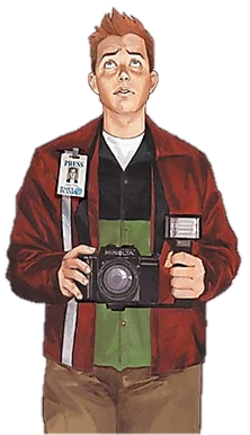Jimmy Olsen
| Jimmy Olsen | |
|---|---|

Jimmy Olsen. Art by Phil Noto, from 9-11: The World's Finest Comic Book Writers and Artists Tell Stories to Remember.
|
|
| Publication information | |
| Publisher | DC Comics |
| First appearance |
Anonymous cameo: Action Comics #6 (November 1938) As Jimmy Olsen: Superman #13 (November/December 1941) |
| Created by |
Jerry Siegel Joe Shuster |
| In-story information | |
| Full name | Jimmy Olsen |
| Team affiliations | Daily Planet |
| Partnerships |
Superman Lois Lane Supergirl |
| Notable aliases | Mr. Action, Elastic Lad, Flamebird, Accountable |
| Abilities | Possesses a wristwatch that calls and signals Superman anywhere on Earth |
James Bartholomew "Jimmy" Olsen is a fictional character who appears mainly in DC Comics’ Superman stories. Olsen is a young photojournalist working for the Daily Planet. He is close friends with Lois Lane and Clark Kent/Superman, and has a good working relationship with his boss Perry White. Olsen looks up to his coworkers as role models and parent figures.
Jimmy is traditionally depicted as a bow tie-wearing, red-haired young man who works as a cub reporter and photographer for The Daily Planet, alongside Lois Lane and Clark Kent, whom he idolizes as career role models. In most depictions of the character, he has a strong friendship with Superman. As Superman's friend, Jimmy has special access to the Man of Steel, thanks to Superman's gift to Jimmy of a "signal watch", a wristwatch which, with the press of a button, emits a special ultrasonic frequency signal that Superman can hear anywhere on Earth. (In Post-Crisis continuity Jimmy invented the watch himself, and Superman briefly considered confiscating it. In New Earth continuity, the watch was designed by Superman based on a larger signaling device Jimmy created.)
In many Silver Age of Comic Books, Jimmy was often seen sharing adventures with Superman, who saved him from various predicaments ranging from dangerous to merely embarrassing. This was particularly pronounced in the series Superman's Pal Jimmy Olsen published from 1954 to 1974, which saw Olsen in a variety of slapstick adventures and strange transformations. Like most DC characters, modern portrayals of Olsen have been more serious in tone.
...
Wikipedia
